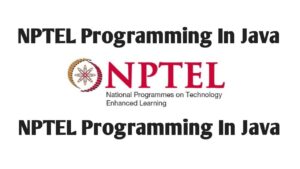Nptel Programming in Java Week 12 Assignment Answers
Nptel Programming in Java Week 12 Assignment Answers
Searching for the Week 12 answers of the NPTEL “Programming in Java” course? You’re in the right spot! Here, you’ll find reliable and up-to-date solutions to help you complete your Week 12 assignment with confidence.

Programming In Java
With the growth of Information and Communication Technology, there is a need to develop large and complex software. Further, those software should be platform independent, Internet enabled, easy to modify, secure, and robust. To meet this requirement object-oriented paradigm has been developed and based on this paradigm the Java programming language emerges as the best programming environment. Now, Java programming language is being used for mobile programming, Internet programming, and many other applications compatible to distributed systems. This course aims to cover the essential topics of Java programming so that the participants can improve their skills to cope with the current demand of IT industries and solve many problems in their own filed of studies.
PREREQUISITES : This course requires that the students are familiar with programming language such as C/C++ and data structures, algorithms.
INDUSTRY SUPPORT : All IT companies.
COURSE LAYOUT – Click To Know More
Nptel Programming in Java Week 12 Assignment Answers
1. What is the correct way to create a thread in Java?
a. Implementing the Runnable interface
b. Extending the Thread class
c. Both a and b ✅
d. None of the above
Correct Answer: c. Both a and b
Explanation: Java supports creating threads using both techniques — implementing the Runnable interface or extending the Thread class.
2. Which method starts a thread in Java?
a. start() ✅
b. run()
c. execute()
d. init()
Correct Answer: a. start()
Explanation: The start() method is used to begin execution of a thread. Internally, it calls the run() method.
3. Which layout arranges components in a row-based order?
a. GridLayout
b. FlowLayout ✅
c. BorderLayout
d. CardLayout
Correct Answer: b. FlowLayout
Explanation: FlowLayout places components in a row, moving to the next line when space is insufficient.
4. What does the setSize(400, 300) method do in a JFrame?
a. Sets the width to 300 and height to 400
b. Sets the width to 400 and height to 300 ✅
c. Maximizes the JFrame
d. Closes the JFrame
Correct Answer: b. Sets the width to 400 and height to 300
Explanation: setSize() sets the dimensions of the JFrame in pixels.
For Latest Update Join our official channel: Click here to join
5. What does the ResultSet object contain in JDBC?
a. Only non-null records from a table
b. All records from a table, including null values ✅
c. Only null records
d. A single column from a table
Correct Answer: b. All records from a table, including null values
Explanation: ResultSet retrieves all rows returned by the SQL query, including rows with null values.
6. What will be the output of System.out.println("hello".length());?
a. 3
b. 5
c. 5 ✅
d. 4
Correct Answer: c. 5
Explanation: The string "hello" has 5 characters, so length() returns 5.
7. What is the correct way to declare an array in Java?
a. int arr = new int();
b. int[ ] arr = new int[5];
c. array = new int[5]; ✅
d. int arr[ ] = new int();
Correct Answer: c. array = new int[5];
Explanation: This is the proper way to allocate an integer array with 5 elements.
8. What will be printed by the following code?
a. J
b. a
c. v ✅
d. A
Correct Answer: c. v
Explanation: "Java".charAt(2) returns the character at index 2, which is 'v'.
For Latest Update Join our official channel: Click here to join
9. What is printed when this code runs?
a. Only “Try block”
b. Only “Finally block”
c. “Try block” followed by “Finally block” ✅
d. Compilation error
Correct Answer: c. “Try block” followed by “Finally block”
Explanation: The finally block always runs after the try, regardless of exceptions (unless the JVM shuts down abruptly).
10. Which Java GUI framework is lightweight?
a. AWT
b. Swing ✅
c. Both A and B
d. None
Correct Answer: b. Swing
Explanation: Swing components are written entirely in Java and are lightweight. AWT components are heavyweight as they rely on native code.